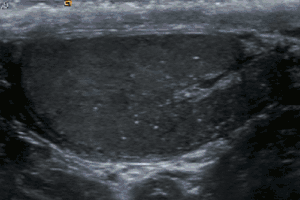Testicular microlithiasis
Testicular microlithiasis is an unusual condition diagnosed on testicular ultrasound. It is found in between 1.5 to 5% of normal males, and may be found in up to 20% of individuals with subfertility. It is an asymptomatic, non-progressive disease.
| Testicular microlithiasis | |
|---|---|
 |

Testicular microlithiasis is not associated with risk of testicular cancer in asymptomatic individuals with no risk factors for testicular germ cell tumor. However, a large meta-analysis has shown that in individuals with associated risk factors for testicular germ cell tumor, the increase in risk of concurrent diagnosis of testicular germ cell tumor, or testicular carcinoma-in-situ upon biopsy is approximately eight to ten-fold.[1]
There is extensive controversy over whether testicular microlithiasis in individuals with testicular germ cell tumor, or risk factors for such, should undergo testicular biopsy to exclude the presence of testicular carcinoma-in-situ, also known as intratubular germ cell neoplasia of unclassified type. Additionally, whether the presence of testicular microlithiasis should influence decision for adjuvant chemotherapy or surveillance in individuals with testicular germ cell tumor remains unclear. A recent review in Nature Reviews Urology has comprehensively evaluated these topics.[2]
Cause
The cause is unknown, but this condition has been associated with testicular cancer in a small group of individuals, cryptorchidism, mumps, infertility and intraepithelial germ cell neoplasia. Classic testicular microlithiasis is defined as five or more echogenic foci per view in either or both testes, and limited testicular microlithiasis defined as one or more echogenic foci that do not satisfy the criteria for classic testicular microlithiasis. In 80% of cases, both testicles are affected.
Diagnosis
Testicular ultrasound
Management
There is no cure or treatment for testicular microlithiasis, however, patients may be monitored via ultrasound to make sure that other conditions do not develop. Emphasis on testicular examination is the recommended follow up for asymptomatic men incidentally identified with testicular microlithiasis. For men with risk factors for testicular germ cell tumor such as subfertility however, individualized discussion with their urologists is necessary.
References
- Tan, IB; Ang, KK; Ching, BC; Mohan, C; Toh, CK; Tan, MH (2010-10-01). "Testicular microlithiasis predicts concurrent testicular germ cell tumors and intratubular germ cell neoplasia of unclassified type in adults: a meta-analysis and systematic review". Cancer. 116 (19): 4520–32. doi:10.1002/cncr.25231. PMID 20578177.
- Tan, Min-Han; Eng, Charis (2011). "Testicular microlithiasis: recent advances in understanding and management". Nature Reviews Urology. 8 (3): 153–163. doi:10.1038/nrurol.2011.1. PMID 21394177.